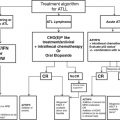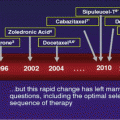© Springer International Publishing Switzerland 2015
Jean-Pierre Droz, Bernard Carme, Pierre Couppié, Mathieu Nacher and Catherine Thiéblemont (eds.)Tropical Hemato-Oncology10.1007/978-3-319-18257-5_48Thyroid Cancer
(1)
Gustave Roussy and University Paris Sud, 114 rue Edouard Vaillant, 94800 Villejuif, France
(2)
Department of Endocrine Oncology and Nuclear Medicine, Institut Gustave-Roussy, Villejuif, France
1 Thyroid Nodules
Clinical thyroid nodules are frequent, being present in 4–7 % of an adult population, and are even more frequent in countries where iodide deficiency has not been corrected. Infra-clinical nodules are much more frequently found with the expanded use of neck ultrasonography [1, 4].
The risk of thyroid cancer among these nodules ranges between 5 and 15 %. However, in view of the high frequency of thyroid nodules and the slow progression rate of small thyroid nodules, even if malignant, there is a general agreement that only thyroid nodules above 1 cm in size with suspicious criteria at clinical examination or at neck ultrasonography deserve further investigations, including serum TSH determination and fine needle aspiration biopsy (FNAB).
Clinical suspicions increase in young patients (<20 years), in those with a hard, irregular, and fixed nodule that grows over time, with ipsilateral persistent lymph nodes in the lower part of the neck and with symptoms of compression, including hoarseness.
When serum TSH is elevated, a treatment with levothyroxine is given, and patients are seen again after 3 months; in contrast, when serum TSH is low or undetectable, the thyroid nodule is likely to be a toxic adenoma and in that case there is no indication for FNAB, but these nodules should be either surgically removed or treated with 131-I.
Solid nodules above 1 cm in diameter should be submitted to FNAB when they are hypoechoic at neck ultrasonography and especially when other suspicious characteristics are present, including suspicious lymph nodes, microcalcifications, irregular infiltrative margins with the absence of halo, evidence for extra-thyroid extension, and a taller than wide shape measured in the transverse dimension. Cytological slides may be sent for interpretation to a specialized center for interpretation with clinical and ultrasonography characteristics and details on nodule sampling.
The strategy will then depend on the cytological results: benign nodules only need follow-up every 12–24 months, without any treatment. Suspicious and malignant nodules are operated. Nodules with indeterminate cytological findings can be submitted to a second FNAB some months later, and then the decision to operate or not will be taken on the basis of clinical, ultrasonography, and cytological data. If not operated, the nodule is followed up every 12–24 months, and an increase in size should then lead to surgery.
2 Differentiated Thyroid Cancer: initial treatment
Most differentiated thyroid cancers can be efficiently treated with surgery that may be complemented by postoperative radioactive iodine (RAI) administration in case of high risk of recurrence or of tumor-related death [1, 4].
2.1 Surgery
Surgery is indicated in case of malignant or suspicious cytologic findings, and its extent depends on the tumor histology and tumor extent and also on the skills of the surgeon.
2.1.1 Thyroid Surgery
There is a general consensus to consider that a lobectomy only is sufficient in patients with unifocal papillary thyroid carcinoma <1 cm in diameter and may also be performed in patients with small minimally invasive follicular carcinoma ajouter (<4 cm). This applies only to patients with a normal contralateral lobe at neck ultrasonography and without evidence of extracapsular extension and lymph node involvement.
Stay updated, free articles. Join our Telegram channel

Full access? Get Clinical Tree





